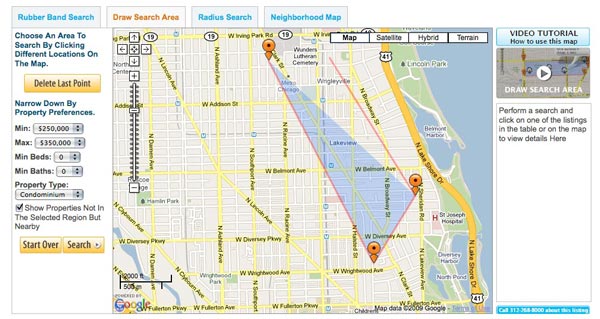
You can now map your own search areas on new websites by @Properties and Dream Town Realty.
Over the past week, two Chicago real-estate companies beefed up their online presence. On October 30th, @Properties went live with its upgraded site, and Dream Town Realty followed suit on November 3rd. Last week, both companies gave me a prelaunch look at their new sites, and I was impressed. Designed to help prospective homebuyers, the two sites do have their differences. @Properties’ homepage has a glossy look, to match its marketing materials, while Dream Town’s opening page fills the screen with boxes delineating the many tools offered at the site.
The two sites have one helpful feature in common. Rather than click on a defined neighborhood area to find listings there, house-hunters can now draw a polygon of any shape or size on a map of the city and call up all the properties on the market within those boundaries. “The highly segmented city ends here,” Dream Town’s president, Yuval Degani, told me as he drew a jagged-edged search map that took in bits of Bucktown, the Gold Coast, and parts in between. (Note that both sites are far stronger on Chicago than the suburbs.)
Both sites also complement an individual listing with tons of information about the surrounding neighborhood. (Especially now—when smart homebuyers know they should plan to stay in their new home for the long term—the neighborhood can be a huge factor in a property’s appeal, said Matt Dollinger, an @Properties performance coach.) That neighborhood info is of two kinds: real-estate market stats—and either site can drill into that to the point of overkill—and “what’s it like to live there?” Dreamtown’s neighborhood search has buttons that can show all sorts of nearby necessities: CTA stations, restaurants, houses of worship, gyms, even pharmacies. @Properties includes a Flickr feed that shows a filmstrip of user photos that are geo-tagged to the chosen location. (Sometimes those photos can be a little eccentric: On Monday, when Deerfield was the featured community on the @Properties site, the Flickr feed was mainly photos from a railroad fan detailing the Amtrak locomotives that passed through the suburb.)
There are literally dozens of other new or upgraded features on the two companies’ sites. Dreamtown has a tool for shopping for foreclosures and other distressed properties, while @Properties provides school information from education.com, as well as a localized news feed “to get it truly hyperlocal,” Dollinger said.
As you explore these sites, keep in mind that the next upgrades are right around the corner. “We’ve already started our research on the next version,” Degani told me—a full week before Dream Town launched its latest version.


